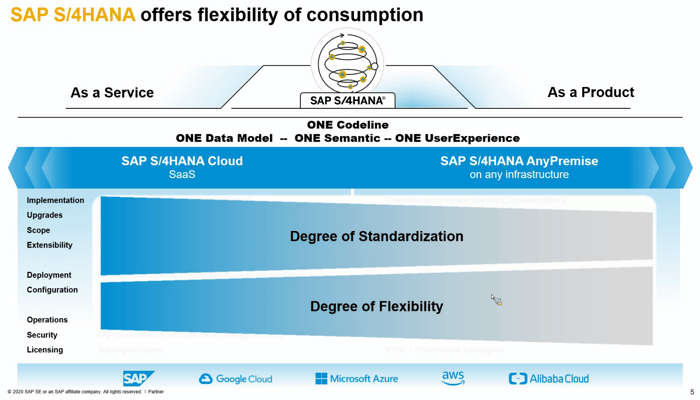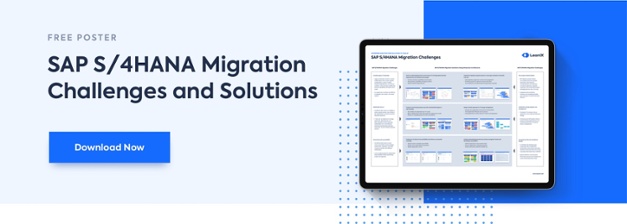SAP S/4HANA On-Premise managed by SAP (HEC)
SAP S/4HANA On-Premise offers individual and private hardware and infrastructure hosted either by SAP, a hyperscaler, or in a data center. It has a Bring Your Own License and infrastructure subscription, allowing more freedom and flexible service offerings. The customer is responsible for managing upgrades and choosing the speed of adoption. Upgrades should be performed annually.
SAP S4 HANA (HEC) has a full S/4HANA industry and country scope, with customization, modification, and extensibility all possible as with ERP. Like S/4HANA Cloud (private), SAP’s on-premise deployment option can be implemented using the new implementation method, system conversions, or selective data transition.
This approach provides tools that selectively transfer configuration and custom code from older ERP systems into SAP S/4HANA by migrating the database, applying software updates, and doing a data conversion from third-party data models to the new, SAP-specific S/4HANA data model. Customers can use the SAP Solution Manager to manage their project design.
SAP S/4HANA On-Premise: On-Premise or managed by cloud provider Hyperscalers
SAP S/4HANA On-Premise or managed by cloud provider hyperscalers (a.k.a. SAP S4 HANA Any Premise) is a deployment option managed by a customer database or third party (hyperscaler; such as Microsoft Azure, AWS, or Google Cloud). The license is either perpetual or Bring Your Own, and upgrades are done annually by the customer. Customization, modification, and extensibility are possible as with the ERP, and configuration uses the full IMG based on a fit-to-standard approach in the Explore phase.
Like on-premise (HEC) and private cloud, implementation can be done through the new implementation, system conversions, or selective data transition. Customers can use SAP Solution Manager to manage their project design.
Deployment factors
There are several factors to consider when choosing which deployment to S/4HANA is best. SAP S4 HANA deployment factors include implementation method, upgrades, and third-party options.
Implementation options
This article has touched upon the three main implementation methods, which will help determine which deployment to go for.
- System Conversion (Brownfield approach): Deployments that allow system conversion are all on-premise deployments and also include S/4HANA Cloud private edition.
- New Implementation (Greenfield approach): All deployment methods can be implemented using the Greenfield approach.
- Selective Data Transition (hybrid approach): Deployments that allow selective data transition are all on-premise deployments and also include S/4HANA Cloud private edition.
How often do you want upgrades?
SAP follows a cloud-first strategy. This means that new software features are developed for the regular releases of SAP S/4HANA Cloud (public). Throughout the year, there will be multiple software releases. All other available deployment options operate on the same software “stack” with the same release strategy.
For this stack, the vast majority of software updates come in, in one main release per year. Most updated in SAP S/4HANA Cloud—but not all of them—make it to this “stack.”
What are the differences between S/4HANA Cloud vs. S/4HANA On-Premise?
Only SAP offers S/4HANA Cloud Single Tenant, a Software-as-a-Service. This means that SAP hosts and runs the OS, SAP software, and upgrades, using SAP Best Practices. S/4HANA On-Premise, on the other hand, is managed by the customer or by a third party like Azure, AWS, or Google that offers IAAS (Infrastructure-as-a-Service).
Even though they may not use SAP Best Practices, these providers look after networking, storage, servers, and virtualization, while the customer manages the OS (including upgrades).
Can you combine deployment methods?
SAP S/4HANA Cloud extended edition is available with infrastructure provided by third-party partners and remains a SAAS offering with SAP. S/4HANA Cloud (private), however, is only available with the SAP (HEC) infrastructure.
Conclusion
Understanding these deployment options is necessary during the SAP S/4HANA migration process, as whichever one you choose will be determined by your enterprise needs, size, and existing infrastructure.
Knowing the difference between each deployment prior to migration will also help any organization keep track of the future product name changes, product upgrades, and other important SAP updates.

 Figure 1: SAP S/4HANA offers the flexibility of consumption. Source:
Figure 1: SAP S/4HANA offers the flexibility of consumption. Source: 
/EN-WP-SAP-S4Hana-Migration-Resource_Page_Thumbnail.png?width=400&height=283&name=EN-WP-SAP-S4Hana-Migration-Resource_Page_Thumbnail.png)
.png?width=260&height=171&name=BTMPlaybook-FI%20(1).png)




